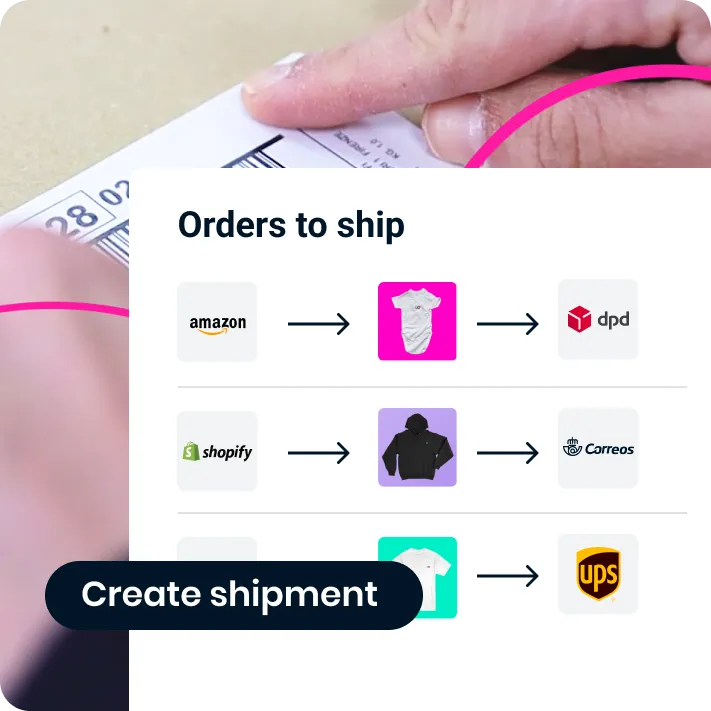An introduction to sustainable logistics for a greener future

These days most of the world’s businesses have sustainability measures in place, including e-commerce. For online businesses, improved sustainability can be implemented in many parts of the supply chain; product materials sourcing, packaging, manufacturing, warehousing, delivery, etc.
In this article we will discuss the importance of sustainable logistics, top sustainability trends, programmes by popular carriers and how to track CO2 emissions to help you meet your corporate sustainability goals.
What are sustainable logistics?
Sustainable logistics maintains the overarching goal of lowering the environmental impact of all logistical activities. This includes all activities related to transport, warehousing, inventory control, order fulfilment, and materials handling. Companies engage with sustainable logistics to lower their CO2 emissions and prevent accidents (such as chemical leaks) that can damage the environment. They also might focus on lowering air, noise and light pollution, all of which can negatively impact people and wildlife.
The logistics industry, which oversees supply chains and major operational activities, has a big responsibility when it comes to sustainability because it can have a very big impact. Sustainability logistics offers mechanisms to lower emissions and balance negative output from factories and deliveries through positive actions. For e-commerce businesses, one of the simplest ways to reduce carbon output is to partner with carriers who are already engaging with sustainable logistics.
What are the benefits of sustainable logistics?
The most obvious benefit of implementing sustainable logistics is environmental. In 2022 the logistics industry emitted 7.97 billion metric tonnes of carbon dioxide into the atmosphere — that’s about a 20% share of all global CO2 emissions.
Benefits the environment
Given the high CO2 output from the logistics industry, sustainable logistics practices can lead to lower greenhouse gas emissions which helps combat climate change. This can be done by streamlining transportation and distribution processes to reduce energy consumption, which also lowers overall operational costs. Sustainable logistics promotes responsible resource management, helping to efficiently use fossil fuels and water.
Saves costs
Optimising logistics can lead to more efficient use of resources which lowers fuel and energy costs and reduces waste. Sustainability measures can also help businesses comply with environmental regulations which prevent fines and legal problems, which could save money in the long run.
Improves supply chain resilience
Sustainability practices can help companies adapt to climate-related disruptions and supply chain vulnerabilities. This often involves diversifying suppliers, warehouse locations and transportation modes which reduces the risk of supply chain disruptions.
Helps businesses stay competitive
Companies with sustainable logistics practices often enjoy a positive public image, which can lead to more sales and customer loyalty. They may also gain access to markets with stricter environmental requirements or preferences for sustainability practices. Consumers and business partners increasingly value sustainability, and companies that prioritise this can foster brand loyalty and better relationships. Furthermore, a commitment to sustainable logistics often requires innovation in supply chain processes and technology which fosters long-term competitiveness.
Social and ethical
The transition to sustainable logistics helps create jobs in green transportation, technology development and the renewable energy sectors. Sustainable logistics often involves engaging with local communities and stakeholders, and a cleaner atmosphere leads to a healthier population. Embracing sustainability often requires transparency in reporting environmental and social impact. This can help build trust with stakeholders and consumers.
Top logistics sustainability trends
Current popular trends in sustainable logistics include improving technology and finding new ways to cut or reduce emissions when transporting goods.
Better warehouse design
How warehouses are designed is an important element of logistical sustainability. This can involve everything from installing solar panels to reducing water waste to improving the flow of picking and packing to reduce the usage of natural resources. Many e-commerce businesses work with warehouse design services to help them spot opportunities to cut back on waste and emissions. More warehouses in busy areas also helps cut down on the travel time to the customer’s door.
Partner with sustainable suppliers
Changing suppliers is never a fun endeavour, especially if you already have a good relationship with them. However, this avenue might be worth exploring if you want to work with suppliers that make sustainability a priority. You should vet your suppliers for ethically and sustainably sourced materials, natural and/or biodegradable packaging and sustainable warehouse management.
Offer greener delivery options
With ShippyPro Ship & Collect it’s easy to provide multiple delivery options to customers. One such option is pick-up / collection from a packstation or corner shop. Customers will get a notification once their product has arrived at a physical location. By allowing customers to walk or bike to a location, you might help reduce the need for fuel-powered vehicles that drive door-to-door. When providing this option during checkout, you’ll want to include a note or tooltip explaining how this option reduces environmental impact.
Partner with sustainability-minded shipping carriers
Most e-commerce businesses don’t handle shipping from order to door. They tend to partner with a carrier such as DHL, Hermes, Royal Mail, etc — or even several carriers based on which markets they service. As delivery and logistics tends to be out of your control, it’s not possible to control the fuel usage and or how they organise last mile delivery. What you can control, however, is which carrier you partner with.
If you have a commitment to sustainable logistics it’s important to research carriers with programmes and initiatives that are bold, future-focused and alight with your own sustainability goals. We have outlined some programmes later in this article.
Sustainable logistics practises
So what exactly can e-commerce companies do to become more sustainable? Since logistics refers to the purchasing, transferring, and delivering of goods, it’s important to pay attention to how they’re stored and moved and well as transferred.
Use sustainable packaging
Packaging is a top trend for e-commerce brands. We spoke with sustainable packaging brand noissue about how branding, customer experience, and sustainability are important elements for packaging.
“Consumers are becoming more aware of the effects that waste and new plastics have on the environment; they understand that packaging is a component of that. With the rise of e-commerce and the ease of online shopping and delivery, more and more parcels and packages are being sent each year. Using compostable or recyclable packaging materials helps give packaging a second life.”
Here are some popular options for sustainable materials:
- Biodegradable packing peanuts
- Corrugated bubble wrap
- Air pillows made of recycled materials
- Cornstarch packaging
- Mushroom packaging
- Seaweed packaging
- Recycled cardboard
- Recycled paper
- Organic fabrics
- Recycled plastics
Optimise transportation routes
Carbon emissions are high in the logistics sector, so route optimisation strategies can be a way to cut back on CO2 emissions and be more efficient overall. This involves evaluating existing routes from improvements and implementing technology (such as GPS tracking integration, real-time traffic updates, smartphone integration, etc) and replanning routes to make them more streamlined, efficient and lower emissions.
Use electric vehicles or bicycles
Lots of carriers are leveraging new ways to deliver packages, including investing more in electric vehicles. Delivery vans and lorries emit millions of tonnes of harmful emissions as they travel up and down the country, so getting more EVs on the road is never a bad idea. EVs and bikes prove especially effective for last mile delivery as they are highly versatile and have a small carbon footprint.
Make use of OOH delivery methods
Out-of-home delivery (OOH) is simply the process of delivering online purchases to a convenient location pre-determined by the customer for collection. It's contactless, flexible, convenient and can be used to support cheap and easy returns. These are some of the various benefits OOH delivery can offer e-commerce businesses. There are two popular types of OOH delivery; Pick-up and drop-off (PUDO) at a specific location near the customer, and automated parcel machines, or parcel “lockers” (APMs). By placing a number of these locations within walking / cycling distance from customers, carriers can reduce the time (end emissions) spent running door-to-door.
Explore green technology where possible
There is a lot of cutting edge technology available for the logistics sector, such as drones, automated forklifts, GPS tracking and APIs that can monitor and transfer data in real-time. The same goes for sustainable logistics. While a lot of technology isn’t always the easiest (or cheapest) to implement, emerging tools like AI and IoT (Internet of Things) can help online businesses manage infrastructure, reduce waste, be more fuel efficient, predict possible issues and speed up decision-making processes.
Communicate updates with consumers
Of course, a top trend when it comes to sustainable logistics is to share what you’re doing with your customers. One-third of consumers will spend 24% more on products that claim to be sustainable — which is why it’s also important that your efforts are intentional and not simply ‘greenwashing.’ Outlining sustainability initiatives could help improve conversion rates and give you an edge over your competitors.
This matters because customers who remain loyal to a brand tend to spend 67% more on products and services than new customers. Sustainability will continue to be an essential KPI towards driving brand loyalty with Gen Z, who make purchasing decisions based on sustainability more than any other consumer generation. So how can you communicate these initiatives? Depending on your brand, you might communicate your commitment to sustainability nearly everywhere or in just a few key places. These might include:
- Media profile descriptions
- Checkout pages
- Delivery options during checkout process
- FAQ
- About and company pages
- Product descriptions
Sustainable logistics programme examples
As mentioned earlier in this article, businesses that partner with sustainable carriers or courier services can help them achieve their sustainability goals. The following examples can also inspire ways to update sustainability goals and involve your employees in community and green projects.
DHL GoGreen
DHL’s GoGreen programme has an ambitious goal: to achieve zero CO2 emissions by 2050. They’ve set goals along the way towards reaching this large goal. By 2025, the company plans to increase carbon efficiency by 50%, reduce air pollution by operating 70% of their first and last mile services with clean solutions like bicycles and electric cars, and certify 80% of employees as GoGreen specialists who will be involved in sustainability initiatives such as tree planting.
DHL has now also introduced GoGreen Plus which means all shipments will be climate neutral. This is done by avoiding transport-generated greenhouse gas emissions and investing in additional emission reduction measures within the DHL Group logistics network
FedEx Priority Earth
Priority Earth is FedEx’s current sustainability programme. Their three-part initiative to advance environmental stewardship includes innovation (better trucks and facilities), outreach (philanthropic endeavours and community construction projects) and education (getting employees involved with making sustainability contributions).
FedEx also creates and shares ESG (Environmental, Social, Governance) reports for anyone to download, improving transparency. The company aims to measure environmental performance and use natural resources more efficiently.
Goals include:
- Reduce aircraft emissions by 30% by 2020
- Increase vehicle efficiency by 30% by 2020
- Get 30% of jet fuel from alternative fuels by 2030
UPS Sustainability
UPS has multiple sustainability measures in place, including donating to environmental organisations, contributing millions of volunteer hours, and planting millions of trees to attempt to offset their carbon emissions. The company is working towards a goal of 40% alternative fuel by 2025 and purchasing 250 million gallons of renewable natural gas. So far the organisation has invested $1 Billion in alt fuel & advanced tech. They are also committed to 100% renewable electricity to power their facilities and 30% sustainable aviation fuel in their air network by 2035.
Royal Mail: Steps to Zero
Royal Mail might be hundreds of years old, but it’s also trying to make its logistics processes more sustainable. The carrier’s goal is to become Net Zero by 2040. Their four goals are:
- Zero emission deliveries
- Zero emission operations
- Become more circular ( enabling reuse models and reducing single use items to make a more ‘circular’ service)
- Drive industry change through innovative partnerships and collaborations
To do this the delivery service is expanding its network of on-foot deliveries, rolling out more electric vans, trialling low-emission trucks and using renewable energy to power buildings which helps reduce emissions further.
ShippyPro is the complete shipping software for online and offline retail. With Label Creator, Track & Trace, Easy Return and Analytics features, our software simplifies your shipping operations. ShippyPro integrates with over 160 couriers and 80 sales channels, making it compatible with a wide range of products and use cases.



